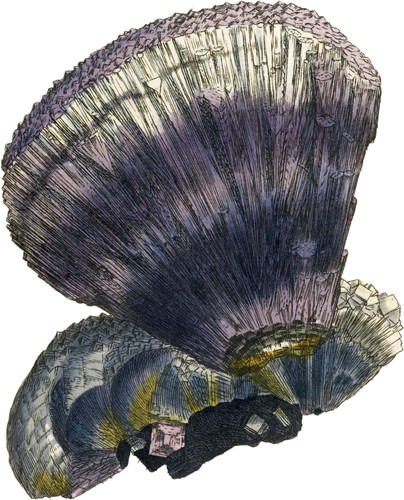 Enlarge
Enlarge
British Mineralogy
Fluor
- Div. 2. Imitative, radiating.
Fluor is perhaps best known to mineralogists in general when crystallized in cubes; in which form it is found in most places, except at Beer Alstone in Devonshire St. Agnes in Cornwall, &c. where it is chiefly in octaëdrons. In Scotland it is rarely known as crystallized (but in octaëdrons, as mentioned tab. 26), and consequently is best known in the amorphous state; but yet the fracture helps its identity. Among those who use it for turning in lathes into vases, candlesticks, and ornaments, it is best understood in radiating masses, in which state it is not thought of sufficient consequence by some mineralogists to claim attention, and is seldom collected.
This substance is so apt to crystallize, that it always shows a tendency to if, and seldom forms (but when it covers other substances) other than lumps or parts of veins, rarely of larger extent than two or three feet in diameter; nor do we hear of rocks or mountains of Fluor, as we do of Limestone.
The upper specimen is probably part of a roundish mass radiating as from a centre; and every concentric circle partly betrays the cubic crystals, and the extremity some determined small ones; while the sides have pressed as it were upon each other so as to give various angles, although the fracture will easily betray the octaëdron. The lower figure is part of a small mass that crystallized in the inner circle as well as the outer, and formed a hollow ball.
| Lime | 67.34 |
| Fluoric Acid | 32.66 |
| 100.00 |
| Lime | 673/4 |
| Fluoric Acid | 321/4 |
| 100.0 |

